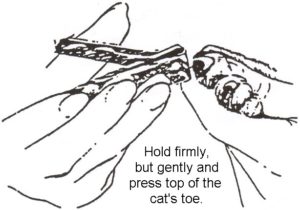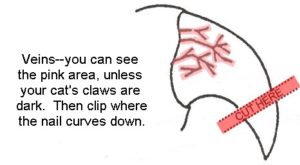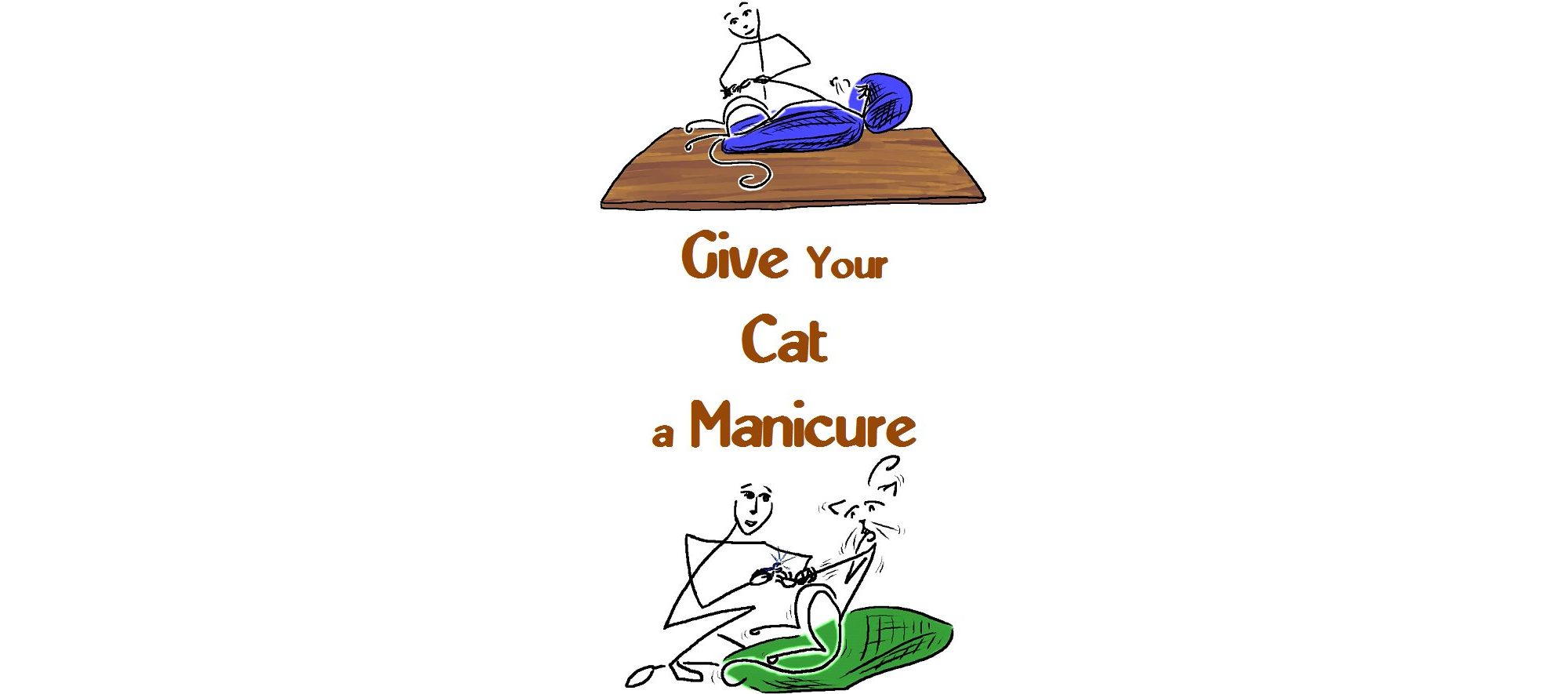ALTERNATIVES TO DECLAWING YOUR CAT
Trim your cat’s front claws regularly to prevent injury or undesirable damage to your furniture, carpeting, and yourself. Use a pair of claw trimmers, if you opt to do it yourself instead of having a pet groomer trim the nails.
Before trimming your cat’s claws, help her get accustomed to having her paws handled and her toes gently squeezed. You can do this by gently petting her legs and paws while giving her a treat. This will help to make it a more pleasant experience. Gradually increase the pressure so that petting becomes gentle squeezing, as you’ll need to do this to extend the claw. Continue the treats until your cat tolerates this kind of touching and restraint. It may take a little longer if she’s not used to having her legs and feet handled. Repeat this until she accepts your handling and squeezing without trying to pull away from you. This could take time–even several days or more. Until you and your cat have become accustomed to the nail clipping routine, one claw or foot a day is enough challenge. Don’t push to do all of them at once, or you’ll both have only negative memories of claw clippers.
Be patient. Trying to force your cat to accept having her nails trimmed could be very painful to you. Go slow and easy and be very gentle. If your cat is not afraid, she’ll relax and cooperate with you. Nail trimming will not be painful. It’s no different than trimming your own nails. Just don’t cut your cat’s nails too short–that is painful. Cats have good memories and will never cooperate with you if you hurt her. Read on and follow our directions, and always clip below where the nail turns downward, and all will be fine.
Cats have a claw (“toenail”) on the end of each toe. Cats normally have five toes on the front feet and four on the hind feet. The fifth claw on the inside of the front paws does not reach the ground and is called the dew claw.
Claws are an extension of two small bones found at the end of each toe. When relaxed, the claws are sheathed inside a skin fold at the end of each toe. To extend the claws, a cat flexes the tendon and straightens the folded bones, which pushes the claws down and forward. This action also spreads the paw to nearly twice its former width.
The exterior claw is composed of a hard, nonliving protein that is white to clear in most cats, and occasionally black. Inside of the claw is living tissue of the nail bed, called the quick, which contains the blood supply and nerve endings. Claws grow out of the quick, rather like human nails, and the outer bony layer of the claw is shed periodically to expose new growth that is razor sharp. Just like human nails, cutting a cat’s nails too short is quite painful.
WHAT CLIPPERS TO USE
 There are several types of claw trimmers designed especially for pets. These are better than your own nail clippers because they won’t crush the claw.
There are several types of claw trimmers designed especially for pets. These are better than your own nail clippers because they won’t crush the claw.
Follow these steps:
Apply a small amount of pressure to her paw with your thumb on top and your index finger underneath the toe of the claw you want to cut. You should be able to see the pink or “quick” which is a small blood vessel. Don’t cut into this pink area, as it will bleed and be painful to your cat. If you cut off just the sharp tip of the claw, the “hook,” it will dull the claw and prevent extensive damage to household items and to your skin. Don’t forget the dewclaw, high on the inside of her paw–a cat’s “thumb.”
 You should clip off the sharp tips of your cat’s claws on her front feet every two weeks or so. Clipping your cat’s claws will also help prevent them from becoming snagged in carpets or fabrics, not to mention your skin!
You should clip off the sharp tips of your cat’s claws on her front feet every two weeks or so. Clipping your cat’s claws will also help prevent them from becoming snagged in carpets or fabrics, not to mention your skin!
SYNTHETIC NAIL CAPS
Another alternative to declawing is to use temporary synthetic nail caps to prevent human injury or damage to property. These are available through a veterinarian, online directly from the company, or through a pet supply store.
Soft Paws
1-800-989-2542
Soft Paws are completely safe, painless, and non-toxic, and can be used on cats of all ages. They were developed by a veterinarian, and have been on the market since 1990. Cats tolerate them extremely well, and most don’t even know they are wearing them.
Even if they are swallowed, no problem will result. They just pass on through the digestive system. The glue is harmless as well. They are designed not to interfere with the normal extension and retraction of a cat’s claws. Your cat can still stretch and make clawing motions, but no damage will occur to your furniture because the claw is effectively covered and protected.
They are vinyl nail caps that are glued on to your cat’s existing nails. They look like a cat’s nail, only hollow. They are easy to apply; simply fill the nail cap with the adhesive provided and slide it on over your cat’s claw. The glue dries very fast. If you can trim your cat’s claws, you can apply the nail caps. Most people apply the caps themselves, while some enlist the help of a friend or family member. Some help is a good idea at first if you are not used to handling your cat alone.
Once the nail caps are applied they remain in place for approximately 4 – 6 weeks, as cats shed the outer sheaths of their claws periodically, and the nail caps come off with the normal shedding of the outer nail sheath. This prevents the possibility of infection. Most people apply Soft Paws only to the front paws, they can also be used on the back if desired.
Each kit contains 40 nail caps and 2 tubes of glue, applicator tips, and instructions, and is relatively inexpensive. Shipping and handling fees are usually added on, and you can buy up to 3 packages for one shipping and handling fee. This is usually a 4 – 6 month supply, if only applied to the front claws.
They come in four sizes–kitten, small, medium and large. Most average-sized cats wear medium. They come in clear, blue, purple, red, and pink, with occasional holiday specialty colors. Contact Soft Paws for current pricing.
They will fall off with the natural growth of your cat’s nails. You should check your cat’s nails periodically because usually just one or two fall off at a time, and these can be easily reapplied.
FURNITURE COVERINGS
Sticky Paws products control cat scratching behavior humanely. The transparent adhesive strips apply directly to fabric and are harmless to cats and furniture when used as directed. They are non-toxic, odor free, and easy to apply, and leave no sticky residue. There are versions for furniture, large areas of carpet, and plants.
A package of the original Sticky Paws is inexpensive. There will be a shipping and handling charge added on. They are also available through pet supply stores. Either phone Sticky Paws or check their website.
Sticky Paws
1-888-697-2873
THE BOTTOM LINE
Realize that scratching is a natural, instinctive behavior. Perhaps a dog, bird, or some other pet would be a better choice for you if you still believe in the very painful, inhumane, and deforming practice of declawing.
1-28-2017bct


